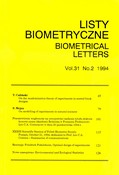
Listy Biometryczne - Biometrical Letters Vol. 31(1994), No. 2, 79-100


|
ON MODELLIG OF EXPERIMENTS IN NATURAL SCIENCE
Stanisław Mejza Department of Mathematical and Statistical Methods, Agricultural University of Poznań, Wojska Polskiego 28, 60-637 Poznań, Poland |

The paper deals with the problems connected with model building for popular types of designed experiments. The one- and two-factor experiments carried out in design with one or more blocking systems are taken into account only. A block design, a nested block design, a row-column design, and a block design with nested rows and columns are considered for one-factor experiments. For two-factor experiments a classic two- (many-) factorial design, a split-plot and split-block design are considered only. The former designs include the incomplete, complete and over complete cases of that designs. Model building is based on some assumptions connected with the experimental unit, its properties and scheme of randomization used in the experiment. In particular, it is assumed that the observed response is a sum of three components: a conceptual response connected with an experimental unit, a pure effect due to treatment (combination) and a technical effect connected with measurements. It means that additivity among these three components is also assumed. Special attention is paid to validity, with respect to the randomization point of view, of linear model assumptions adopted in many applications. The paper is the survey paper where research done by the author in the considered area is reported.

randomization, additivity, model building, designs with block struc¬tures, factorial experiments
